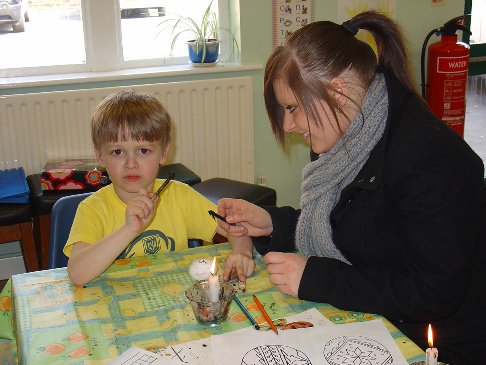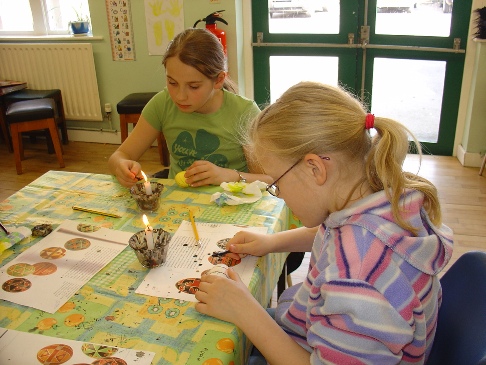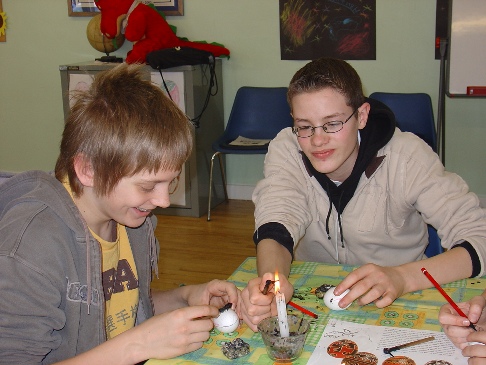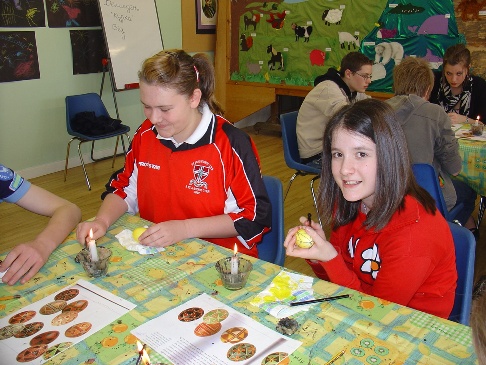|

Pysanky
Ancient legend says the first pysanky came from the sky. A cold and bitter winter swept across the land that meant migrating birds had no chance to fly to warmer lands and began to fall to the ground. Peasants gathered the frozen creatures and brought them into their homes where they were fed and kept warm during the winter. In spring, the birds were set free and flew away, returning several days later with a pysanka for each peasant for saving their lives and ever since that time, according to legend, pysanky were decorated in spring.
The most ancient pysanky were simple made with two colours, but gradually peasants learned to create other colours and more variety was used to decorate the eggs. Colours were symbolic and dyes were usually prepared by boiling a substance in water until the desired colour was obtained. Vinegar was added to strengthen the colour.
Traditional Colours and Symbols
| Traditional Colours of Pysanky |
| White |
White symbolises purity. Eggs with totally white backgrounds were usually reseved for the graves of younger children. |
| Yellow |
Yellow on a pysanka means the moon and stars and symbolises a successful harvest and wisdom. Yellow dye was made from dry onion skin, bark of wild apple trees, buckwheat husks and the lilac flower. |
| Green |
Green symbolises spring, rebirth of nature and wealth of the plant kingdom. It also represents freshness, untouched happiness and youth and was an age old symbol of innocence. Dyes were made from winter rye, grass and leaves. |
| Blue |
Blue symbolises the sky, air, magic and good health and was used in small amounts to add contrast to warm colours. Dyes were prepared from marrow or logwood. |
| Orange |
Orange represents power, endurance and ambition. Passion is red, wisdom is yellow and the combination of the two colours gives the sun's colour or orange and everlasting warmth. |
| Red |
Red represents the sun, happiness in life, hope and passion. Dyes were made from red onion skins, raspberries, rose-hips, beetroot juice or plums. |
| Brown |
Brown represents the colour of the earth and far away mountains. Dyes were made from oak bark, tea or coffee. |
| Purple |
The colour was always associated with royalty and on a pysanka represents faith and trust. |
| Black |
Black often signified the darkest time before daybreak. In Ukrainian tradition, the period between the first and third crow of the cockeril, was a time when souls of the dead were thought to travel. Dyes were made from oak bark or walnut husks, though the easiest was to collect soot from the fireplace and mix it with hot water. |
| Black and White |
The combination represented protection from evil and were also made to honour departed souls. Such pysanky decorated bridges and gates and given to older people. |
| Traditional Symbols of Pysanky |
| Sun |
The most ancient and widely used symbol, the source of light and life. |
| Star |
Represented with even numbers, six or eight points, and believed to foretell good fortune. |
| Birds |
Represent spring, good harvest and pushing away of evil. |
| Heart |
The symbol of love and found at the centre of the pysanka with surrounding patterns. |
| Fruits and Vegetables |
Represent not only a good harvest but also good life. Designs were used to beckon all plant life to grow and ripen more quickly. |
| Flowers |
Represent beauty and children. |
| Wheat |
Signifies the life's work of the Ukrainian farmer. |
| Spider |
The spider is said to have healing powers and bring good fortune. Grandparents told children not to kill spiders because "Having a spider in the house brings good luck." |
| Animals |
Represent prosperity and wealth. |
| Forty Triangles |
Represent many facets of life such as births, weddings, travel, etc. In Christian times, the forty triangles represented the forty days of Lent and the forty days of Christ's fasting. |
| Circle |
A circle has no begining or no end and eveil cannot penetrate it. A circle is a symbol of protection. |
| Sky, Sun, Moon and Stars |
The sun is found at the top of the pysanka sending out rays to the moon at the bottom. In between are stars. This is old design symbolises people begging the sun to give its healing warmth to earth and the moon to shed light to help the traveller and chase away evil from homes. |
| Trees |
Represent long life, good health and strength. Bark and acorns from the oak were cooked in water and cooled and then used to bathe a sick child to make him as strong as an oak. |
| Vinok |
The garland of flowers worn by girls around their heads. On pysanky they are drawn in three circles round the egg representing birth, marriage and life. |
| Cross |
The symbol for good luck. A cross also signifies Jesus Christ's gift to man, His crucifixion and resurrection. |
| Grapes |
The sign of a good harvest and more recently the sign of a growing church. |
| Bees |
The symbol of hard work and pleasantness and represent all good insects that should not be killed. |
| Snake |
The snake protects all people living on a house and brings protection from catastrophy. |
| Fish |
The fish symbolises Jesus Christ. |
| Water |
Represented by two or three waves providing wealth since without rain there can be no harvest. |
Every year sumivtsi in Bradford have classes where they have the opportunity to decorate eggs in time for Easter Sunday and this year, sumenyata, molodshi, starshi and druzhynnyky all participated - see below.
Next year if you would like to decorate eggs, hopefully the colours and symbols described above will give you some ideas and help you decide how you want your pysanka to look.






 |



